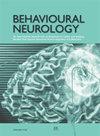Presence and Characteristics of Behavioral and Psychological Symptoms in Subacute Stroke Patients with Cognitive Impairment
IF 2.7
4区 医学
Q2 CLINICAL NEUROLOGY
引用次数: 0
Abstract
This retrospective cross-sectional study is aimed at investigating the prevalence and characteristics of behavioral and psychological symptoms (BPS) in subacute stroke patients with cognitive impairment. The Neuropsychiatric Inventory-Questionnaire (NPI-Q) was used to assess BPS. A total of 358 consecutive patients with first-ever stroke admitted to rehabilitation wards and with Mini-Mental State Examination (MMSE) on admission were included. BPS was defined as a total NPI-Q Severity or Distress . Differences between the severity and presence of BPS among patients with severe cognitive impairment (MMSE scores 0–17) and those with mild cognitive impairment (MMSE scores 18–23) were analyzed using the Mann–Whitney test and chi-squared test, respectively. Eighty-one patients (mean (standard deviation) age, 73.5 (13.1) years) were enrolled for analysis. BPS were observed in 69.1% and 74.1% of patients when assessed with NPI-Q Severity and NPI-Q Distress, respectively. The most frequently observed BPS was apathy, followed by depression (approximately 44% and 40%, respectively). The severity and frequency of delusions, euphoria, apathy, and disinhibition were significantly higher in the severe cognitive impairment group than in the mild cognitive impairment group. However, the severity, distress, and frequency of depression were not dependent on the severity of cognitive impairment. The presence of BPS, especially apathy and depression, in subacute stroke patients with cognitive impairment is high. The severity and frequency of some BPS are higher in patients with severe cognitive impairment than in those with mild cognitive impairment. However, depression is highly prevalent among the patients regardless of the severity of cognitive impairment.有认知障碍的亚急性脑卒中患者的行为和心理症状及其特征
这项回顾性横断面研究旨在调查有认知障碍的亚急性脑卒中患者行为和心理症状(BPS)的发生率和特征。研究采用神经精神症状问卷(NPI-Q)来评估行为和心理症状。研究共纳入了 358 名连续入住康复病房的首次脑卒中患者,这些患者在入院时均进行了迷你精神状态检查(MMSE)。BPS 被定义为 NPI-Q 严重度或窘迫度的总和。采用曼-惠特尼检验(Mann-Whitney test)和卡方检验(chi-squared test)分别分析了严重认知障碍患者(MMSE 评分 0-17 分)和轻度认知障碍患者(MMSE 评分 18-23 分)的 BPS 严重程度和存在程度的差异。共有 81 名患者(平均(标准差)年龄为 73.5(13.1)岁)被纳入分析。在使用 NPI-Q 严重度和 NPI-Q 痛苦度进行评估时,分别有 69.1% 和 74.1% 的患者观察到 BPS。最常见的 BPS 是冷漠,其次是抑郁(分别约占 44% 和 40%)。妄想、兴奋、冷漠和抑制的严重程度和频率在严重认知障碍组明显高于轻度认知障碍组。然而,抑郁的严重程度、痛苦程度和频率与认知障碍的严重程度无关。有认知障碍的亚急性卒中患者出现 BPS,尤其是冷漠和抑郁的比例很高。与轻度认知障碍患者相比,重度认知障碍患者某些 BPS 的严重程度和频率更高。然而,无论认知功能障碍的严重程度如何,抑郁在患者中都非常普遍。
本文章由计算机程序翻译,如有差异,请以英文原文为准。
求助全文
约1分钟内获得全文
求助全文
来源期刊

Behavioural Neurology
医学-临床神经学
CiteScore
5.40
自引率
3.60%
发文量
52
审稿时长
>12 weeks
期刊介绍:
Behavioural Neurology is a peer-reviewed, Open Access journal which publishes original research articles, review articles and clinical studies based on various diseases and syndromes in behavioural neurology. The aim of the journal is to provide a platform for researchers and clinicians working in various fields of neurology including cognitive neuroscience, neuropsychology and neuropsychiatry.
Topics of interest include:
ADHD
Aphasia
Autism
Alzheimer’s Disease
Behavioural Disorders
Dementia
Epilepsy
Multiple Sclerosis
Parkinson’s Disease
Psychosis
Stroke
Traumatic brain injury.
 求助内容:
求助内容: 应助结果提醒方式:
应助结果提醒方式:


